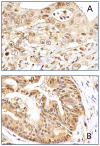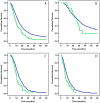Biomarkers of TGF-β signaling pathway and prognosis of pancreatic cancer
- PMID: 24465802
- PMCID: PMC3896410
- DOI: 10.1371/journal.pone.0085942
Biomarkers of TGF-β signaling pathway and prognosis of pancreatic cancer
Abstract
Background: Transforming growth factor (TGF)-β signaling pathway, may act both as a tumor suppressor and as a tumor promoter in pancreatic cancer, depending on tumor stage and cellular context. TGF-β pathway has been under intensive investigation as a potential therapeutic target in the treatment of cancer. We hypothesized a correlation between TGF-βR2/SMAD4 expression in the tumor, plasma TGF-β1 ligand level, genetic variation in TGF-B pathway and prognosis of pancreatic cancer.
Method: We examined TGF-βR2 and SMAD4 protein expression in biopsy or surgical samples from 91 patients with pancreatic ductal adenocarcinoma (PDAC) using immunohistochemistry. Plasma level of TGF-β1 was measured in 644 patients with PDAC using ELISA. Twenty-eight single nucleotide polymorphisms (SNP) of the TGF-β1, TGF-β2, TGF-β3, TGF-βR1, TGF-βR2, and SMAD4 genes were determined in 1636 patients with PDAC using the Sequenom method. Correlation between protein expression in the tumor, plasma TGF-β1 level, and genotypes with overall survival (OS) was evaluated with Cox proportional regression models.
Results: The expression level of TGF-βR2 and SMAD4 as an independent marker was not associated with OS. However, patients with both low nuclear staining of TGF-βR2 and high nuclear staining of SMAD4 may have better survival (P = 0.06). The mean and median level of TGF-β1 was 15.44 (SD: 10.99) and 12.61 (interquartile range: 8.31 to 19.04) ng/ml respectively. Patients with advanced disease and in the upper quartile range of TGF-β1 level had significantly reduced survival than those with low levels (P = 0.02). A significant association of SMAD4 SNP rs113545983 with overall survival was observed (P<0.0001).
Conclusion: Our data provides valuable baseline information regarding the TGF-β pathway in pancreatic cancer, which can be utilized in targeted therapy clinical trials. High TGF-β1 plasma level, SMAD4 SNP or TGF-βR2/SMAD4 tumor protein expression may suggest a dependence on this pathway in patients with advanced pancreatic cancer.
Conflict of interest statement
Figures



Similar articles
-
Prognostic significance of transforming growth factor beta (TGF-β) signaling axis molecules and E-cadherin in colorectal cancer.Tumour Biol. 2012 Aug;33(4):1005-14. doi: 10.1007/s13277-012-0333-3. Epub 2012 Jan 26. Tumour Biol. 2012. PMID: 22278155
-
Negative control of TRAIL-R1 signaling by transforming growth factor β1 in pancreatic tumor cells involves Smad-dependent down regulation of TRAIL-R1.Cell Signal. 2016 Nov;28(11):1652-62. doi: 10.1016/j.cellsig.2016.07.016. Epub 2016 Aug 1. Cell Signal. 2016. PMID: 27492861
-
Targeting endogenous transforming growth factor beta receptor signaling in SMAD4-deficient human pancreatic carcinoma cells inhibits their invasive phenotype1.Cancer Res. 2004 Aug 1;64(15):5200-11. doi: 10.1158/0008-5472.CAN-04-0018. Cancer Res. 2004. PMID: 15289325
-
SMAD4 and the TGFβ Pathway in Patients with Pancreatic Ductal Adenocarcinoma.Int J Mol Sci. 2020 May 16;21(10):3534. doi: 10.3390/ijms21103534. Int J Mol Sci. 2020. PMID: 32429474 Free PMC article. Review.
-
The Smad family and its role in pancreatic cancer.Indian J Cancer. 2011 Jul-Sep;48(3):351-60. doi: 10.4103/0019-509X.84939. Indian J Cancer. 2011. PMID: 21921337 Review.
Cited by
-
Unraveling the interplay: exploring signaling pathways in pancreatic cancer in the context of pancreatic embryogenesis.Front Cell Dev Biol. 2024 Aug 22;12:1461278. doi: 10.3389/fcell.2024.1461278. eCollection 2024. Front Cell Dev Biol. 2024. PMID: 39239563 Free PMC article. Review.
-
TGFβ Signaling in the Pancreatic Tumor Microenvironment.Cancers (Basel). 2021 Oct 11;13(20):5086. doi: 10.3390/cancers13205086. Cancers (Basel). 2021. PMID: 34680235 Free PMC article. Review.
-
Relationships between SMAD3 expression and preoperative fluoropyrimidine-based chemoradiotherapy response in locally advanced rectal cancer patients.World J Surg. 2015 May;39(5):1257-67. doi: 10.1007/s00268-014-2917-0. World J Surg. 2015. PMID: 25561186
-
Biomarkers and Targeted Therapy in Pancreatic Cancer.Biomark Cancer. 2016 Apr 26;8(Suppl 1):27-35. doi: 10.4137/BiC.s34414. eCollection 2016. Biomark Cancer. 2016. PMID: 27147897 Free PMC article. Review.
-
Significant function and research progress of biomarkers in gastric cancer.Oncol Lett. 2020 Jan;19(1):17-29. doi: 10.3892/ol.2019.11078. Epub 2019 Nov 11. Oncol Lett. 2020. PMID: 31897111 Free PMC article. Review.
References
-
- Bernabeu C, Lopez-Novoa JM, Quintanilla M (2009) The emerging role of TGF-beta superfamily coreceptors in cancer. Biochimica et Biophysica Acta 1792: 954–973. - PubMed
-
- Joshi A, Cao D (2010) TGF-beta signaling, tumor microenvironment and tumor progression: the butterfly effect. Frontiers in Bioscience 15: 180–194. - PubMed
Publication types
MeSH terms
Substances
Grants and funding
LinkOut - more resources
Full Text Sources
Other Literature Sources
Medical
Miscellaneous

